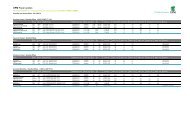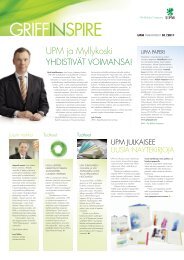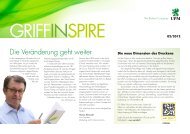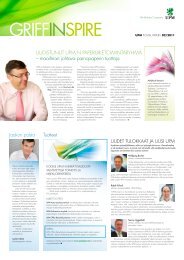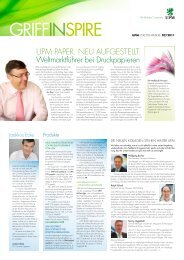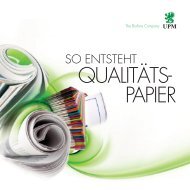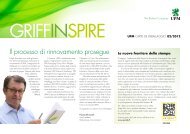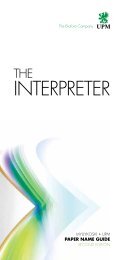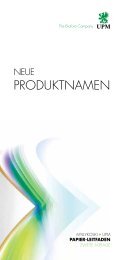The answers you need â righT now - UPM Paper
The answers you need â righT now - UPM Paper
The answers you need â righT now - UPM Paper
Create successful ePaper yourself
Turn your PDF publications into a flip-book with our unique Google optimized e-Paper software.
<strong>UPM</strong> AP CUSTOMER MAGAZINE 2/2012<br />
<strong>UPM</strong> FLASH<br />
Cooperation in a Green way<br />
<strong>The</strong> <strong>answers</strong> <strong>you</strong> <strong>need</strong><br />
– right <strong>now</strong><br />
www.upm.com
EDITORIAL<br />
A new Chapter<br />
for <strong>UPM</strong>!<br />
Since its establishment in later 1990s, <strong>UPM</strong> was able to progressively<br />
increase its footprint in the APAC region, investment in<br />
few phases has allowed us to provide an expanded offering to our<br />
customers in this dynamic territory. Today we are marking another major milestone in the development<br />
of our Changshu operations. <strong>The</strong> decision to build a new paper machine at Changshu<br />
mill in China will further strengthen our presence in the Asian paper market, especially in the<br />
value chain of self-adhesive materials.<br />
<strong>The</strong> new machine is designed with a swing capacity catering to the evolving demands: It is<br />
capable of producing up to 360,000 tonnes of wood free uncoated grades or 170,000 tonnes<br />
of uncoated high quality release base papers. <strong>The</strong> total investment is 3 billion CNY (390 million<br />
EUR) and the machine is expected to be operational by the end of 2014. In addition, we are<br />
finalising the construction of a 100,000 tonnes cut-size sheeting line, which will enhance our<br />
deliverability and service capability in office paper grades in the region.<br />
<strong>UPM</strong> FLASH<br />
2/2012<br />
<strong>UPM</strong> Flash is <strong>UPM</strong> <strong>Paper</strong> Business<br />
Group’s customer magazine in Asia<br />
Pacific region.<br />
EDITORIAL BOARD: Lenny Zhong,<br />
Vivian Wang, Jackie Bao, Mary Ma<br />
EXECUTIVE EDITOR: Ada Qin (Chinese<br />
Version), MOLI Design (Chinese<br />
and English Version)<br />
LAYOUT: MOLI Design<br />
PAPER: <strong>UPM</strong> Finesse premium silk 250<br />
g/m 2 (cover), <strong>UPM</strong> Finesse premium<br />
silk 130g/m 2 (inside)<br />
SUBSCRIPTION: fax 86 (21) 5292<br />
8912 or email upm.flash@upm.com<br />
Please email <strong>you</strong>r feedback on Flash<br />
magazine to: upm.flash@upm.com<br />
<strong>UPM</strong> in-house magazine<br />
We realize the promising outlook in both label and woodfree uncoated paper products. In this<br />
challenging time of the global economy, it is crucial to place our focus in the high performing<br />
market, leveraging our long standing global expertise and advanced solution in the self-adhesive<br />
and release liner industry. Those experience will be very valuable for our local customers here<br />
in Asia.<br />
Given our extensive sales and logistic networks today in the region, we are well positioned<br />
to support <strong>you</strong> with excellent service and high quality products. Our recently launched <strong>UPM</strong><br />
Customer Online tool also provides <strong>you</strong> the real time visibility of <strong>you</strong>r supply chain information.<br />
You are highly encouraged to utilize this web-based platform to track <strong>you</strong>r order status 24/7.<br />
As an environmental-friendly company, we take pride in our world leading environmental<br />
performance in the paper mills, and our dedication to driving innovation and environmental<br />
excellence has always been the foundation of our success.<br />
<strong>UPM</strong> China & Asia-Pacific<br />
Sales Network<br />
Shanghai: 86 21 6288 1919<br />
Korea: 82 2 723 0555<br />
Hong Kong: 852 2527 0177<br />
Singapore: 65 6838 7280<br />
Japan: 81 3 5778 2660<br />
Australia: 61 2 9334 5000<br />
www.upm.com<br />
We look forward to building upon our strong relationships in APAC as we enter the new chapter.<br />
Jaakko Nikkila<br />
Vice President, Sales<br />
Asia Pacific<br />
<strong>UPM</strong> <strong>Paper</strong> Business Group<br />
2 / 2 . 2012 / <strong>UPM</strong> FLASH
CONTENTs<br />
10<br />
Drupa exhibition proved<br />
that print has great potential<br />
EDITORIAL 02<br />
News 04<br />
FEATURE STORY<br />
<strong>The</strong> <strong>answers</strong> <strong>you</strong> <strong>need</strong> – right <strong>now</strong> 08<br />
Drupa exhibition proved<br />
that print has great potential 10<br />
18<br />
CUSTOMER STORY<br />
Printing Pioneer 12<br />
A leading variable information<br />
specialty paper producer 15<br />
CORPORATE RESPONSIBILITY<br />
Cooperation in a Green way 18<br />
TECHNOLOGY FRONTLINE<br />
An introduction to dot of printing 20<br />
08<br />
MARKETING INFORMATION<br />
Key Points of <strong>The</strong> 12th Five-Year Plan for<br />
China Pulp and <strong>Paper</strong> Industry 22<br />
PRODUCT & SERVICE 23<br />
15<br />
<strong>UPM</strong> FLASH / 2 . 2012 / 3
NEWS<br />
<strong>UPM</strong> CEO Pesonen states confidence in <strong>UPM</strong>’s<br />
growth businesses underlining importance of<br />
solid margins in Europe<br />
Jussi Pesonen, <strong>UPM</strong>’s President and CEO,<br />
stated his confidence in the company’s growth<br />
businesses during its Capital Markets Day in<br />
London. He also underlined the importance<br />
of improved margins in the mature European<br />
businesses to maximize the cash flow of the<br />
company.<br />
“<strong>UPM</strong>’s growth businesses sales today exceed<br />
EUR 4.0 billion and we have confidence<br />
in further growth going forward. More than<br />
50% of our sales will derive from these solid<br />
performing growth businesses on latter half<br />
of this decade,” said Pesonen.<br />
Pesonen highlighted that since 2007, <strong>UPM</strong>’s<br />
Energy, Pulp, Label and Asian <strong>Paper</strong> business<br />
have grown by 40 % in the topline.<br />
As future sources of top line growth, he identified<br />
<strong>Paper</strong> in China, an expanding Pulp<br />
business, continued Label expansion in the<br />
emerging markets, biofuels and nuclear power<br />
generation - where <strong>UPM</strong> has a significant holding<br />
through the Finnish energy company TVO.<br />
“Our first investment in biofuels will add a<br />
totally new dimension to the business portfolio<br />
and growth outlook,” said Pesonen. “In<br />
the longer term, biocomposites, biofibrils and<br />
biochemicals will also complement the business<br />
portfolio.”<br />
“While other businesses have grown, sales of<br />
our mature <strong>Paper</strong>, Timber and Plywood businesses<br />
have come down by 10 % since 2007.<br />
However, these businesses have a pivotal role<br />
in our growth strategy. We are expanding in<br />
growth businesses with the cash flow generated<br />
by the mature businesses. Improving<br />
margins for strong cash flow and releasing<br />
capital from our mature businesses is crucial.<br />
To this end, further consolidation in the<br />
industry is <strong>need</strong>ed,” said Pesonen.<br />
<strong>UPM</strong> grows in China and in the fast developing label materials segment<br />
<strong>UPM</strong> takes further steps to reshape its business<br />
portfolio and expands in profitable<br />
growth businesses in Asia. <strong>The</strong> company will<br />
increase its presence in the attractive Asian<br />
paper segments and strengthen its position in<br />
the label materials value chain by building a<br />
new woodfree speciality paper machine at its<br />
Changshu mill in China.<br />
“This move is aligned with our strategic target<br />
to have more than 50 % of our sales from<br />
well performing growth businesses in the latter<br />
part of the decade. It supports our growth<br />
in China and provides an excellent platform<br />
to strengthen partnerships with self-adhesive<br />
labelstock customers and expand into new<br />
end uses in Asia. It also supports the good<br />
profitability of our growth businesses,” says<br />
Jussi Pesonen, <strong>UPM</strong>’s President and CEO.<br />
<strong>The</strong> new machine is an uncoated woodfree<br />
speciality machine capable of producing up to<br />
360,000 tonnes of uncoated woodfree grades<br />
and high quality label papers. <strong>The</strong> machine<br />
will start up by the end of 2014. <strong>The</strong> investment<br />
will also include future-oriented infrastructure<br />
investments in the Changshu site.<br />
<strong>The</strong> total investment cost is CNY 3,000 million<br />
(EUR 390 million). In addition, <strong>UPM</strong><br />
Changshu is finalising a 100,000 tonnes cutsize<br />
sheeting line investment which strengthens<br />
the Group’s leading position in office<br />
paper grades in China.<br />
Both label paper and uncoated woodfree papers<br />
have a healthy demand outlook in Asia.<br />
<strong>The</strong> annual growth of <strong>UPM</strong>’s label paper<br />
mix is expected to be 8 % in Asia and 4 %<br />
globally. In uncoated woodfree grades, <strong>UPM</strong><br />
focuses on high quality office paper, where<br />
the Chinese market is expected to grow by<br />
8 % annually.<br />
4 / 2 . 2012 / <strong>UPM</strong> FLASH
<strong>UPM</strong> named “Most Innovative Company” at 2012 Ethical Corporation Awards<br />
<strong>UPM</strong> has been awarded “Most Innovative<br />
Company” at the 2012 Ethical Corporation<br />
Awards held in London. <strong>UPM</strong> was highlighted<br />
for its Eco Design approach and overall<br />
sustainable thinking. <strong>UPM</strong>’s innovative approach<br />
has seen new products created such<br />
as the world’s first biodiesel manufactured<br />
from wood raw material.<br />
“Our focus on producing more with less is<br />
a clear example of <strong>UPM</strong> as a forest industry<br />
company is <strong>now</strong> creating tangible results<br />
with bio composites, bio fuels and the use of<br />
non-fossil fuel energy,” comments Hartmut<br />
Wurster, Executive Vice President Technology<br />
and responsible for new businesses and<br />
environmental issues.<br />
“<strong>The</strong> integration of the bio-based and forest<br />
industries has created the Biofore vision the<br />
foundation of our corporate responsibility.”<br />
A spokesperson for Ethical Corporation<br />
commented: “<strong>The</strong> judges commended <strong>UPM</strong><br />
for its commitment to creating innovative<br />
materials for increased recyclability and<br />
robustness.This is traditionally a very challenging<br />
category and the judges commended<br />
the effort of all entrants to demonstrate<br />
genuine innovation in their sustainability<br />
approach.”<br />
<strong>UPM</strong> has brought to market several innovative<br />
products recently including <strong>UPM</strong> ForMi<br />
a composite material made from pulp fibres<br />
from sustainably managed forests and<br />
clean plastic polymers. It has also launched<br />
the fuel of the future, <strong>UPM</strong> BioVerno, the<br />
first wood-based biofuel. <strong>UPM</strong> aims to be a<br />
major player in the production of advanced<br />
transportation biofuels.<br />
<strong>UPM</strong> plants thousands of trees with school children<br />
<strong>UPM</strong> organises a global Plant a Tree Day<br />
each year in spring and especially on May<br />
22nd, the UN International Day for Biodiversity.<br />
This year school children and other<br />
stakeholders in Finland, the UK, Russia,<br />
China, the US and Uruguay participated in<br />
Plant a Tree events.<br />
In Finland the school children and <strong>UPM</strong><br />
forest professionals plant trees together in<br />
Pyhäjärvi, Nokia and Joroinen. <strong>UPM</strong> participates<br />
also as a partner in the ENO tree planting<br />
day in Espoo, one of the global events<br />
organized by ENO Environment Online. <strong>The</strong><br />
seedlings for these events come from <strong>UPM</strong>’s<br />
nursery in Joroinen, which produces high<br />
quality seedlings of native origin to be used<br />
to regenerate <strong>UPM</strong> forest service customers’<br />
and <strong>UPM</strong> company forests.<br />
“A tree seedling and a school child are creators<br />
of the future,” says Päivi Salpakivi-Salomaa,<br />
Vice President, <strong>UPM</strong> Environment.<br />
“Planting a tree is an investment and good<br />
for the climate. A growing tree sequestrates<br />
atmospheric carbon throughout its lifetime.<br />
<strong>The</strong> new forest improves the quality of surface<br />
and ground water, it creates the preconditions<br />
for berry and mushroom production<br />
and makes a habitat for hundreds of other<br />
species.”<br />
Every year <strong>UPM</strong> plants more than 50 million<br />
tree seedlings. <strong>The</strong> long time span of sustainable<br />
forestry materialises in tree planting.<br />
Forest regeneration is a central element of<br />
responsible forest management.<br />
<strong>UPM</strong> FLASH / 2 . 2012 / 5
NEWS<br />
“Care for a Green Future”<br />
summer camp inspires students<br />
<strong>UPM</strong>’s “Care for a Green Future” summer<br />
camp was held on July 18. <strong>The</strong> event raising<br />
awareness of environmental protection<br />
brought together 47 teachers and students<br />
from four local primary schools. <strong>The</strong> governors<br />
from Changshu Environmental Protection<br />
Bureau, Municipal Education Bureau<br />
and Law Promotion Division also attended<br />
the summer camp.<br />
During the summer camp, students visited<br />
the Changshu mill and gained insights into<br />
paper-making technology. <strong>The</strong> students also<br />
practiced team working skills by making<br />
paper-cut art works and putting together a<br />
green fashion show using recycled materials.<br />
“<strong>The</strong> summer camp is an extension of <strong>UPM</strong><br />
green education and it enables us to experience<br />
the meaning of environmental protection<br />
first-hand and see environmental<br />
protection in action,” says Headmaster Fei<br />
of the Lv Di Primary School.<br />
“Through the summer camp activities, we<br />
hope the students will take home green thinking,<br />
and start making small steps toward<br />
making a larger environmental difference<br />
in their everyday lives,” says Lenny Zhong,<br />
Head of <strong>UPM</strong> Communications, APAC.<br />
<strong>UPM</strong> Clean Run campaign stresses environmental<br />
leadership<br />
In 2011, <strong>UPM</strong> launched the Clean Run campaign aiming to further reduce the environmental impact<br />
of <strong>UPM</strong> operations. <strong>The</strong> campaign encourages all employees to strive towards a greener <strong>UPM</strong><br />
through actions in daily work including discussions, performance assessments, and operation audits.<br />
One of the major steps of the Clean Run campaign has been the mill operation audit. Päivi Rissanen,<br />
Environmental Director from <strong>UPM</strong> headquarters in Finland, audited the clean operations<br />
of Changshu mill during May 22-23, 2012. During the mill operation audit, Rissanen inspected<br />
energy and water consumption as well as other emission data at the mill’s power plant, wastewater<br />
processing plant, and production workshop.<br />
Changshu mill has performed well on the Clean Run campaign. Besides the enhancement of employee<br />
environmental training, the mill has made substantial investments in equipment improvement,<br />
including a German filtering device to further reduce the suspended solids in wastewater.<br />
6 / 2 . 2012 / <strong>UPM</strong> FLASH
NEWS<br />
<strong>UPM</strong> Changshu mill upgrades Preprint <strong>Paper</strong>s<br />
In September, <strong>UPM</strong> Changshu mill upgraded its Fine Preprint <strong>Paper</strong>s. <strong>The</strong> upgraded<br />
preprint papers not only provide customers with more options on grammage, but also<br />
extend the whiteness to fully meet requirements of different customers.<br />
<strong>The</strong> <strong>UPM</strong> Preprint <strong>Paper</strong>s includes two types of products: <strong>UPM</strong> Fine Preprint and<br />
<strong>UPM</strong> Fine Premium Preprint.<br />
<strong>UPM</strong> Fine Preprint line has expanded from the 60, 70 and 80 g/m2 series to 60, 70, 80,<br />
90, 100 and 120 g/m2. <strong>UPM</strong> Fine Premium Preprint still includes the 70g/m2 and 80g/<br />
m2. <strong>The</strong> whiteness has been upgraded by three grades, including CIE whiteness 145,<br />
155 and 167.<br />
<strong>UPM</strong> Preprint range covers papers for all<br />
main preprint end uses. It’s suitable for<br />
documents such as invoices, bank account<br />
and insurance statements, advertising leaflets<br />
or any kind of direct mail. Both FSC<br />
and PEFC certified Preprint papers are<br />
available.<br />
<strong>UPM</strong> sponsors printing skills competition in China<br />
Mini-pack of <strong>UPM</strong> Jetset<br />
Presentation launched<br />
<strong>The</strong> mini-pack of <strong>UPM</strong> Jetset Presentation<br />
is <strong>now</strong> available in the Chinese market. 100<br />
sheets of copy paper in A4 size are packed<br />
into a smaller plastic bag with a self-adhesive<br />
sealing. <strong>The</strong> smaller pack provides an easy<br />
choice for consumers to carry, use and storage.<br />
This year, <strong>UPM</strong> sponsored the Third National Occupational Skill Competition for the<br />
Printing Industry, following on the success of its sponsorship of the same event in 2010.<br />
As the exclusive paper sponsor for the competition, <strong>UPM</strong> provided competition paper<br />
to the final round of the competition. <strong>The</strong> paper used was the 105g <strong>UPM</strong> Finesse classic<br />
gloss produced by <strong>UPM</strong> Changshu mill.<br />
<strong>The</strong>re were two series in the competition: the six-day student competition was held on<br />
May 29 in Shenzhen and drew 119 students from national printing colleges and technology<br />
schools. <strong>The</strong> competition for industry representatives including 150 participants was<br />
held in Shenzhen on Aug 13. <strong>UPM</strong> Finesse classic gloss paper performed as expected,<br />
providing superlative paper performance ensuring the fairness of the competition.<br />
<strong>UPM</strong> wins government<br />
bid in China<br />
<strong>UPM</strong> has won the bidding for the 2012 governmental<br />
procurement for information products<br />
with its <strong>UPM</strong> Jetset,<br />
Copykid, Yes, Future<br />
and Office series copy<br />
paper. <strong>The</strong> papers<br />
were cited for their<br />
high quality, excellent<br />
environmental<br />
credentials and<br />
reliable service.<br />
<strong>UPM</strong> FLASH / 2 . 2012 / 7
featUre stOrY<br />
Text: Ada Qin Photos: <strong>UPM</strong><br />
<strong>The</strong> <strong>answers</strong> <strong>you</strong> <strong>need</strong><br />
– right <strong>now</strong><br />
<strong>The</strong> newly upgraded <strong>UPM</strong> Customer Online tool provides customers the convenience<br />
and accessibility to track their order status anywhere at any time, enabling <strong>UPM</strong> to<br />
offer superior services.<br />
Ms. Guo Zhijun, General Manager of Shanghai Guantian<br />
<strong>Paper</strong> Co., Ltd. (SGP), is a regular user of the<br />
<strong>UPM</strong> Customer Online service. <strong>The</strong> service fits<br />
her busy schedule as it allows her to track orders<br />
quickly and efficiently.<br />
“In the past, we had to phone or fax <strong>UPM</strong> Customer Service Specialist<br />
to obtain our order information. Now, it is much more convenient<br />
and the information is easy to access,” says Guo Zhijun.<br />
SGP is a professional paper distributor that has grown rapidly<br />
for 15 years in Shanghai market and is one of <strong>UPM</strong>’s earliest<br />
customers in China.<br />
“We’ll most often look into order status when our customers <strong>need</strong><br />
an urgent delivery. So, ideally we would like to get order information<br />
within a few minutes so that we can answer our customers<br />
promptly. Through conventional ways such as phone and fax, that<br />
just wasn’t possible,” explains Guo Zhijun.<br />
SGP and other customers began to use <strong>UPM</strong> Customer Online<br />
about two years ago. In March this year, <strong>UPM</strong> launched an<br />
upgraded version offering better performance and improved user<br />
friendly interface.<br />
Available all the time<br />
<strong>The</strong> prime advantage of <strong>UPM</strong> Customer Online is providing customers<br />
with real time online information - 24 hours a day, seven<br />
days a week. With a computer or a portable computing device,<br />
like IPAD and an Internet connection, customers can log onto the<br />
8 / 2 . 2012 / <strong>UPM</strong> FLASH
featUre stOrY<br />
system anywhere at any time.<br />
In the system, the customers have a wealth<br />
of information at their fingertips: order<br />
status, delivery status, stock information,<br />
and invoices. Customized reports can be<br />
requested at the click of a mouse and all<br />
changes are updated in real-time.<br />
“After office hours, if a <strong>UPM</strong> Customer Service<br />
Specialist is not available, we can check<br />
our order status, and print copies of the information<br />
we <strong>need</strong>. K<strong>now</strong>ledge of order status<br />
allows our logistics planners to make proper<br />
arrangements,” says Ms. Makiko Nakao of<br />
Marubeni Corporation.<br />
“We anticipate that by the end of this year<br />
more and more customers in the Asia-Pacific<br />
Region will be using <strong>UPM</strong> Customer Online<br />
to support their business,” says Tim Huang,<br />
E-business Manager of <strong>UPM</strong> Asia-Pacific<br />
Region.<br />
Efficiency and cost savings<br />
Customers appreciate the efficiency gains<br />
provided by the new system. Chengdu Zhenxingheng<br />
Trade Co., Ltd. (CZT) is one of the<br />
largest copy paper dealers in Southwest<br />
China. This March, they began to use <strong>UPM</strong><br />
Customer Online Service, and were amazed<br />
by the system capability.<br />
“<strong>The</strong> new system allows us to get the most<br />
up-to-date information on order quantities,<br />
delivery times, invoices and allows us to calculate<br />
our rebates. Gathering such information<br />
before was time consuming, but <strong>now</strong><br />
that we’ve tailored the system to our <strong>need</strong>s,<br />
the information can be with us in an instant,”<br />
says Ms.Yan, a CZT Accountant.<br />
Shu Yuqiong, the CZT account manager, also<br />
spoke highly of the cooperation with <strong>UPM</strong>.<br />
“Out of all the paper suppliers we work with,<br />
<strong>UPM</strong> is the only one who can offer an online<br />
customer service system,” says Shu.<br />
Guo Zhijun, GM of SGP, also underlined<br />
the saving advantage of using the customer<br />
online service.<br />
“In the past, all our reports were printed by<br />
fax. <strong>The</strong> resulting piles of paper were all<br />
stored in a warehouse, and because of confidentiality<br />
issues, had to be shredded before<br />
disposal. It goes without saying, that the system<br />
has provided us a lot of efficiency and<br />
savings.” says Guo Zhijun.<br />
“I like the new <strong>UPM</strong> online customer service<br />
very much,” praises Kathy Law, a buying<br />
clerk from the Samson Group in Hong Kong.<br />
“It’s fast, and the dashboard is clean and easy<br />
to navigate.”<br />
Improved management control and<br />
overall business planning<br />
To give the users a better experience, each<br />
customer can customize the interfaces to their<br />
<strong>need</strong>s. Customers can also create user-defined<br />
printed reports.<br />
“Having easy access to the information and<br />
reports allows the management to have better<br />
control and visibility of their own daily<br />
operation and enhance their business planning.”<br />
Says York Fang, VP Supply Chain,<br />
<strong>UPM</strong> Asia Pacific.<br />
“We have received many positive feedbacks<br />
from our customers but we are striving to<br />
incorporate more functionality to the system<br />
such as placing orders on line, track and<br />
trace function and other system updates. Ultimately,<br />
the system will be developed to meet<br />
the evolving customer <strong>need</strong>s. It also plays a<br />
key role in shaping our high quality customer<br />
service!”<br />
<strong>UPM</strong> FLASH / 2 . 2012 / 9
featUre stOrY<br />
Drupa exhibition proved<br />
that print has great potential<br />
Text: Thomas Ehrnrooth Photos: <strong>UPM</strong><br />
At the drupa exhibition in May I realised at the latest, how much<br />
the paper and printing industry have changed during the past six<br />
years I spent in another business. Technological development,<br />
innovations and new features made me impressed.<br />
10 / 2 . 2012 / <strong>UPM</strong> FLASH
featUre stOrY<br />
service for comprehensive workflow, colour<br />
and print quality management.Also our environmental<br />
team had a strong presence at our<br />
stand and our customers and other stakeholders<br />
got to k<strong>now</strong> the new <strong>UPM</strong> Responsibility<br />
HUB website as well as our brand new <strong>UPM</strong><br />
<strong>Paper</strong> Life video among other interesting topics<br />
discussed during the exhibition.<br />
Having a long history in the paper<br />
business I was expecting to meet<br />
the good old drupa atmosphere at<br />
the biggest expo of the worldwide<br />
print and media industry – but my expectations<br />
did not realise. <strong>The</strong>re was something<br />
new in the air this time.<br />
Drupa 2012 - held in Germany, Düsseldorf -<br />
was clearly showing that despite of the huge<br />
challenges the whole industry is facing – print<br />
has potential and the sector is renewing and<br />
investing heavily in its future.<br />
As the world’s leading manufacturer of<br />
graphic papers, we wanted to stand out at the<br />
fair above all as a frontrunner and a partner<br />
that keeps up with the times, who strongly<br />
believes in paper and print – today and tomorrow.<br />
That was well recognised and appreciated<br />
by our customers too.<br />
Our stand supported the chosen theme and we<br />
succeeded extremely well in presenting paper<br />
as a gateway to new and inspiring experiences<br />
by introducing the third dimension of print at<br />
our stand. Augmented reality, QR codes and<br />
other examples of combining print and digital<br />
content were a hot topic at drupa and also an<br />
integral part of our appearance there. Our<br />
own experts and visionary cooperatives were<br />
showcasing exciting examples of combining<br />
digital and print – providing inspiration and<br />
solutions to all in the media industry.<br />
<strong>UPM</strong>’s services were well present at the<br />
stand. As part of our technical service offering<br />
we showcased <strong>UPM</strong> ColorCTRL, a new<br />
An international trade fair, drupa, is the biggest exhibition of<br />
the print and media industry. <strong>The</strong> event is held every four years<br />
and it brings together media and printing professionals from<br />
all around the world. This year drupa trade fair gathered over<br />
314,000 experts and almost 2,000 exhibitors from more than<br />
130 countries to Düsseldorf, Germany in May. More information<br />
can be found at www.drupa.com.<br />
Despite the first impression <strong>you</strong> might have<br />
got as a visitior drupa is not only an exhibition<br />
for digital printing. After what I have<br />
heard and seen at the exhibition I believe that<br />
both digital and analog printing will continue<br />
living in a constructive co-existence also in<br />
the future.<br />
During drupa the Landa Corporation launched<br />
a new printing method that is based on the<br />
nano- technology aiming to set a new industry<br />
standard for mainstream printing. <strong>The</strong> most<br />
unique feature in the presses is probably that<br />
they are operated by a touch screen which<br />
looks looking like a giant iPad. Due to the<br />
high degree of automation a single operator<br />
can manage even four presses at a time. It is<br />
interesting to see, if Landa will be showing<br />
the way also for other companies.<br />
<strong>The</strong> finals of the “SHOTS Heard Around the<br />
World” print simulator-based productivity<br />
contest culminated during the expo. Over<br />
150 students from Asia, Europe and North<br />
America had been remotely competing at<br />
their technical schools and the best students<br />
met face-to-face at drupa.<br />
Simulation-based training is <strong>now</strong> a worldwide<br />
norm in almost every profession. We<br />
have been using printing simulators successfully<br />
for several years to train customers and<br />
our own staff to improve their understanding<br />
on the printing processes.<br />
Let’s continue to explore the new opportunities<br />
paper and print have to offer!<br />
<strong>UPM</strong> FLASH / 2 . 2012 / 11
customer story<br />
Text: Ada Qin Photos: <strong>UPM</strong><br />
12 / 2 . 2012 / <strong>UPM</strong> FLASH
<strong>The</strong> acquisition of cutting edge equipment<br />
was the first step. Next Shengtong was chalcustomer<br />
story<br />
Printing Pioneer<br />
Business for Beijing Shengtong Printing is flourishing in the Chinese high-end<br />
printing market. <strong>The</strong> company is ready to expand its market and go global.<br />
<strong>UPM</strong> and Shengtong Printing have<br />
been cooperating with each other<br />
for over a decade. <strong>The</strong> partnership<br />
has been especially fruitful<br />
in northern China.<br />
Since Shengtong Printing was listed on the<br />
Shenzhen Stock Exchange Small and Medium-sized<br />
Enterprise board in July 2011,<br />
this private-run printing company has gained<br />
interest and standing in the public eye. Shengtong<br />
Printing developed rapidly during its<br />
first decade, multiplying its sales income<br />
tenfold, and gaining a firm foothold in the<br />
high-end publication and commercial printing<br />
market. Shengtong Printing’s customers<br />
include many well-k<strong>now</strong>n publishing houses<br />
and magazines including the Xinhua News<br />
Agency, People’s Education Press, Foreign<br />
Language Teaching and Research Press, as<br />
well as Outlook, Money Weekly, and Marie<br />
Claire. In addition, Shengtong Printing’s<br />
hardback book products have earned a favorable<br />
reputation in the overseas markets;<br />
such as in Europe. In the brutally competitive<br />
printing industry, Shengtong has risen<br />
high on the list of China’s top 100 printing<br />
enterprises.<br />
“<strong>UPM</strong> has consistently provided us with high<br />
quality paper, and we feel that the product<br />
quality is as good as <strong>UPM</strong>’s world-class<br />
reputation,” says Li Yanqiu, Vice-President<br />
and one of the founders of Shengtong<br />
Printing.“Through the close relationship, we<br />
get insights into the changes and future direction<br />
of the international paper making and<br />
printing industry.”<br />
Li Yanqiu credited three factors that have<br />
been key in the success of Shengtong Printing:<br />
vision, determination, and focus.<br />
Target high-end market<br />
<strong>The</strong> Shengtong Printing entrepreneurial and<br />
management team have broad experience in<br />
the printing industry. During the rapid development<br />
of the printing industry at the turn<br />
of the century, Shengtong’s entrepreneurial<br />
team recognized that the competition in the<br />
printing industry was focused on the middle<br />
and low-end of the market.<br />
“<strong>The</strong> middle and low-end printing market<br />
was still profitable at that time, but the long<br />
run prospects were limited and the competition<br />
was becoming increasingly fierce,” says<br />
Li Yanqiu.<br />
At that time in the export printing business in<br />
the coastal areas of China, there were also foreign-invested<br />
printers. However, the Shengtong<br />
team found there was a significant gap<br />
in the product quality of world-class printers<br />
and theirs. Since its establishment in 2000,<br />
Shengtong has aimed their development strat-<br />
Li Yanqiu, Vice-President and one of the<br />
founders of Shengtong Printing.<br />
egy at the mid-to-high end printing market.<br />
An industry pioneer<br />
To break through the high-end printing market<br />
Shengtong Printing went on the path of<br />
continuous improvement; especially made a<br />
bold move for investment in printing equipment<br />
and technology, Shengtong soon have<br />
a leading position in the market. In 2002,<br />
Shengtong acquired a GOSS M600 printing<br />
press for printing high-end periodicals<br />
to become the first private-run printer to own<br />
such advanced printing equipment in China.<br />
<strong>UPM</strong> FLASH / 2 . 2012 / 13
customer story<br />
Shengtong Printing’s customers include<br />
many well-k<strong>now</strong>n publishing houses and<br />
magazines including the Xinhua News<br />
Agency, People’s Education Press, Foreign<br />
Language Teaching and Research Press,<br />
as well as Outlook, Money Weekly, and<br />
Marie Claire.<br />
lenged to learn how to get the most out of the<br />
equipment. Both the founders and the management<br />
team of Shengtong Printing waded<br />
through the study and training in order to<br />
master the technology.This in turn led to the<br />
opening of a new market.<br />
Shengtong staked its reputation on staying<br />
current with international cutting-edge<br />
printing equipment and technology. Over<br />
ten years of development, Shengtong has<br />
been ranked at the top of printing industry,<br />
introducing computer-to-plate (CTP) digital<br />
printing technology, the most advanced<br />
American and German printing machines and<br />
a powerful post-press system. Innovation is<br />
always the company’s culture, according to<br />
this, Shengtong designed and installed two<br />
commercial keel transmission systems and<br />
became one of the first printers in China to<br />
introduce the keel transmission system into<br />
the heatset web offset printing. Shengtong independently<br />
developed an enterprise resource<br />
planning (ERP) system for their own business<br />
management, applying information technology<br />
to the production management and has<br />
made great strides in improving production<br />
and operational efficiency.<br />
Committed to sustainability think<br />
Shengtong is also k<strong>now</strong>n in the industry for<br />
its commitment to the environment. In 2009,<br />
Shengtong was among the first to join the<br />
Beijing Green Printing Industry Technology<br />
Innovation Association. After joining,<br />
Shengtong invested heavily in green printing<br />
and environmental protection, and has been<br />
awarded the Green Award and green certification<br />
by authorities every year. Using environment-friendly<br />
ink, paper, and pre-press<br />
materials, Shengtong Printing has even infused<br />
the idea of energy conservation and low<br />
carbon into their plant design and construction<br />
as well as equipment model selection.<br />
<strong>The</strong> ECLOCOOL drier used with the GOSS<br />
Sunday2000/24p wide high-speed Heatset<br />
Web Offset Printing Press adopts secondary<br />
combustion technology, and the watercooling<br />
device for the Heidelberg Format 70<br />
x100 8-color Sheetfed Offset Printing Press<br />
have the latest cleaning and energy saving<br />
mechanisms.<br />
Shengtong Printing and <strong>UPM</strong>’s shared commitment<br />
to the environment has become a<br />
key factor for long-term cooperation and has<br />
also won the respect of the high-end market.<br />
“Environmental protection reflects the values<br />
and attitudes of an enterprise. When Shengtong<br />
was established, we set a very definite<br />
goal: to make our development sustainable.<br />
We later found it consistent with the theme of<br />
green printing,” says Li Yanqiu. “Sustainability<br />
is at the heart of our strategic development<br />
and this allows us to adopt an integrated approach<br />
in all aspects of our business including<br />
marketing, business management, and<br />
investment.”<br />
14 / 2 . 2012 / <strong>UPM</strong> FLASH
customer story<br />
Text: Ada Qin Photos: Guangdong Guanhao & <strong>UPM</strong><br />
Guangdong Guanhao<br />
– a leading variable information<br />
specialty paper producer<br />
Guangdong Guanhao, the industry leader for Chinese direct thermal paper and carbonless<br />
paper, has joined forces with <strong>UPM</strong> to create new businesses in the label industry.<br />
Guangdong Guanhao’s specialty<br />
paper products are widely used<br />
across China in many forms:<br />
value-added tax invoices, express<br />
mail labels, ATM slips, train tickets,<br />
and supermarket receipts.<br />
“We are the first large scale specialty paper<br />
manufacturer in China for direct thermal paper<br />
and carbonless paper,” says Li Zhen,<br />
the Vice General Manager of Guangdong<br />
Guanhao.<br />
Guangdong Guanhao High-Tech Co., Ltd,<br />
founded in 1993, is a leading enterprise in<br />
the Chinese specialty paper industry with a<br />
current annual base paper capacity of 60,000<br />
tons and annual coating capacity of 150,000<br />
tons. Its products are used by tax agencies,<br />
post offices, banks, and business services.<br />
High-tech Products<br />
Guangdong Guanhao targets medium and<br />
high-end markets for both its direct thermal<br />
paper and carbonless paper. In 1990s,<br />
Guanhao began to enter the carbonless paper<br />
market.<br />
<strong>The</strong> company introduced the most advanced<br />
carbonless paper production line from Switzerland<br />
and adopted microcapsule technology<br />
from Germany, a method crucial to carbonless<br />
paper production. It also partnered with<br />
leading Chinese researchers in order to develop<br />
cutting edge carbonless copy products.<br />
In the following years, the carbonless paper<br />
market developed rapidly, and Guanhao was<br />
<strong>UPM</strong> FLASH / 2 . 2012 / 15
customer story<br />
ready to meet the <strong>need</strong>s of the market. With<br />
its technology, equipment and talent people,<br />
the company gained a sizable market share.<br />
According to Li Zhen, carbonless paper<br />
stands out as a successful product case study<br />
in the specialty paper industry. “<strong>The</strong> annual<br />
global demand has reached over 3 million<br />
tons, benefiting from the requirements of<br />
international accounting standards. <strong>The</strong> annual<br />
growth of China’s carbonless paper sales<br />
(including export growth) is over 20 percent.<br />
Third party statistics show that the carbonless<br />
paper capacity of China reached 450,000<br />
tons in 2011.”<br />
In terms of total output, Guanhao is not the<br />
largest manufacturer in China, but the company<br />
targets markets requiring higher product<br />
quality and greater added value.<br />
“We seldom enter areas like computer form<br />
which have relatively low product quality<br />
requirements,” says Li Zhen. “Our strength is<br />
in providing customized direct thermal paper<br />
products which are individually formulated to<br />
meet our customers’ requirements exactly.”<br />
<strong>The</strong> most valued characteristic of direct<br />
thermal paper is its ability to print variable<br />
information rapidly without changing ink<br />
cartridges. Direct thermal printing is used<br />
extensively to print tickets, logistics labels,<br />
supermarket cashier receipts and ATM receipts.<br />
<strong>The</strong> print quality of these direct thermal<br />
printed documents must be sharp because<br />
of their valuable content of information.<br />
“Train tickets require heat-resistant direct<br />
thermal printing paper that demands a special<br />
production process. Some paper may also<br />
<strong>need</strong> to go through a special coating process<br />
so that the direct thermal printed information<br />
lasts,” explains Li Zhen.<br />
Changing Markets<br />
Carbonless paper once enjoyed extraordinary<br />
growth in specialty paper sales and its annual<br />
sales growth rate in the Chinese market is still<br />
relatively high.<br />
“However, the multi-ply layers carbonless<br />
paper market is declining year by year in the<br />
global market, especially in the European-<br />
American countries, because of the impact<br />
of informatization,” says Li Zhen.<br />
Li Zhen also points out two reasons why carbonless<br />
paper output in China continues to<br />
grow.<br />
“Firstly, Chinese informatization hasn’t<br />
reached the levels of the developed countries,<br />
and secondly, Chinese firms have considerable<br />
export potential. However, we realize that<br />
the market will eventually come to a halt.”<br />
In comparison, growth in the direct thermal<br />
paper market is showing no signs of slowing<br />
down. According to third party data, direct<br />
thermal paper displays stable global growth<br />
with total output reaching 800,000 tons in<br />
2011. At the same time, direct thermal paper<br />
output in China has maintained a double-digit<br />
increase with total output reaching 110, 000<br />
tons in 2011.<br />
“Although the demand of direct thermal<br />
paper for fax machines is decreasing, tickets,<br />
invoices for logistics, supermarket labels<br />
and cashier receipts, continue to show<br />
healthy growth potential. In this respect, we<br />
can see that new applications are stimulating<br />
demand.”<br />
From the point view of Li Zhen, Guanhao’s<br />
achievements in the field of variable information<br />
specialty paper can be attributed to its<br />
long-term development strategy.<br />
Label Cooperation with <strong>UPM</strong><br />
Several years ago, Guanhao turned its attention<br />
to the label industry. In 2008, Guanhao<br />
imported a label production line with the most<br />
advanced technology at that time. This formally<br />
marked the start of its investment in<br />
the adhesive label materials.<br />
“We feel that the demand for label markets<br />
is very high. Statistically, the Chinese label<br />
16 / 2 . 2012 / <strong>UPM</strong> FLASH
customer story<br />
“Through our partnership we<br />
k<strong>now</strong> that <strong>UPM</strong>’s products and<br />
services are fit-for-purpose.”<br />
market’s sales growth is twice that of the GDP and what’s more important<br />
is that Chinese label consumption per capita is far lower than that of the<br />
developed countries,” says Li Zhen.<br />
<strong>The</strong> variable information label has a huge market, in which Guanhao has<br />
natural advantages and solid experience.<br />
More than two years ago, <strong>UPM</strong> started to cooperate with Guanhao as the<br />
supplier of the glassine paper for label base paper. “Through our partnership<br />
we k<strong>now</strong> that <strong>UPM</strong>’s products and services are fit-for-purpose. No<br />
matter whether it has been in putting together the formula for our label<br />
products or providing us advice on our label production line, we’ve been<br />
provided with strong technology and service support. Working with <strong>UPM</strong><br />
has been excellent in every way,” Li Zhen says with certainty.<br />
Juhani Ylikoski, Sales Director of <strong>UPM</strong> Converters Segment in Asia-<br />
Pacific, said <strong>UPM</strong> is very optimistic about the growth potential of specialty<br />
paper in the Asia-Pacific region and China.<br />
“We are currently building a professional technical service team here,<br />
hoping to share our many years of accumulated experience in specialty<br />
paper with local manufacturers. We’re utilizing our experience, technology,<br />
products and strong service orientation to help clients grow<br />
rapidly, and to create a win-win situation,” says Juhani. Recently, <strong>UPM</strong><br />
has announced an investment in a new woodfree uncoated and label paper<br />
production line in China, aiming to meet the constantly increasing<br />
market demand of high quality label and release liners product in China<br />
and the Asia Pacific region.<br />
“At present, the Chinese label market is still led by international brands.<br />
With cooperation with our international partners, such as <strong>UPM</strong>, we believe<br />
that Guanhao has the capability to reach a leading market position<br />
by becoming the key local representative for labels,” Li Zhen affirms.<br />
<strong>UPM</strong> FLASH / 2 . 2012 / 17
CORPORATE RESPONSIBILITY<br />
Text: Mary Ma Photos: <strong>UPM</strong><br />
Cooperation in a Green way<br />
— <strong>UPM</strong> visits WWF and Greenpeace headquarters in China<br />
On a sunny day in Beijing,<br />
<strong>UPM</strong> Asia Pacific Marketing<br />
and Business Development<br />
Director Ali Malassu, Global<br />
Environmental Director Päivi Rissanen,<br />
and Asia Pacific Environmental Marketing<br />
Manager Mary Ma sat down for a meeting<br />
with representatives of global environmental<br />
organizations World Wide Fund for<br />
Nature (WWF) and Greenpeace. <strong>The</strong> aim<br />
was to discuss environmental protection<br />
issues and explore opportunities for future<br />
cooperation.<br />
Green partners<br />
<strong>UPM</strong> has a close partnership with WWF<br />
globally. In the International Year of Forests<br />
2011, <strong>UPM</strong> and WWF worked together to<br />
produce their joint symbol for forest protection.<br />
<strong>The</strong> symbol includes the WWF panda<br />
logo and the slogan “Working with <strong>UPM</strong><br />
to Protect Our Forests”. <strong>The</strong> symbol underlines<br />
both organizations’ aim to promote<br />
sustainable forest management and the use<br />
of products from sustainable forests.<br />
But the partnership of the two parties does<br />
not end there. <strong>UPM</strong> has also supported<br />
WWF’s paper evaluation system “Check<br />
Your <strong>Paper</strong>”, participated in WWF’s annual<br />
“Earth Hour”, and cooperated with<br />
WWF to promote Next-generation Plantation<br />
Project. In 2011, the project team<br />
visited Yunnan and Sichuan provinces to<br />
improve the economic benefits of planting<br />
and harvesting of forests and improve the<br />
income of local residents.<br />
WWF entered China over 20 years ago,<br />
and currently has around 100 employees in<br />
China in 10 different offices. WWF works<br />
mainly in the Yangzi River Basin, Heilongjiang<br />
River Valley, Yellow Sea biological<br />
area, Upper Mekong River and Tibet.<br />
Major projects include saving the Siberian<br />
Tiger, promoting the expansion of nature<br />
reserves, Yangzi River Basin water conservation,<br />
the promotion of forest management<br />
and FSC forest certification. Recently WWF<br />
has focused on the protection of forest and<br />
water resources.<br />
Zhong Dexin, Cooperation and Development<br />
Director for WWF, has praised<br />
<strong>UPM</strong>’s environmental protection efforts and<br />
achievements. Regarding sustainable forests<br />
and forest products, both parties agreed<br />
to carry out deeper and broader cooperation<br />
and jointly promote the development of<br />
FSC certified paper in the Chinese market.<br />
“<strong>UPM</strong> Changshu mill has been FSC certified<br />
since 2006. <strong>The</strong> long-term publicity and<br />
promotion of the FSC concept has achieved<br />
remarkable results, with more and more users<br />
beginning to pay attention to FSC certified<br />
paper,” says Ali Malassu. “We are<br />
delighted that FSC-certified <strong>UPM</strong> Jetset is<br />
used at all WWF offices in China.”<br />
18 / 2 . 2012 / <strong>UPM</strong> FLASH
CORPORATE RESPONSIBILITY<br />
Positive action will bring change<br />
After the visit to WWF, the <strong>UPM</strong> team<br />
traveled to Greenpeace Headquarters<br />
in Beijing. <strong>The</strong>re they met with Li Yifang,<br />
the Senior Project Director, and<br />
Forest Protection Project Manager Liu<br />
Bing to discuss the marketing prospects<br />
of environmental and sustainable<br />
forest products. Greenpeace is another<br />
advocate of FSC certification.<br />
In early 2009, Greenpeace launched<br />
the “Book Lovers for Forests” campaign<br />
and engaged in promoting forest<br />
friendly book publishing together with<br />
publishing houses, paper suppliers,<br />
authors and the public. Greenpeace<br />
called on well-k<strong>now</strong>n authors and<br />
publishing houses to use environmentally<br />
friendly paper, including recycled<br />
paper and FSC-certified paper.<br />
One of the recent Greenpeace projects<br />
addressing harmful chemicals and the<br />
safety of foods and agricultural products<br />
is chemical product management.<br />
In line with this, <strong>UPM</strong> has guaranteed<br />
that no harmful chemicals have been<br />
added to paper production, so consumers<br />
can rest assured when using <strong>UPM</strong><br />
products.<br />
“We not only carried out very detailed<br />
multi-level discussions, but also considered<br />
many projects that have potential<br />
for cooperation. We expect<br />
to further cooperate with world re<strong>now</strong>ned<br />
environmental organizations<br />
such as WWF and Greenpeace to protect<br />
our environment and improve the<br />
public’s environmental awareness,”<br />
says Ali Malassu.<br />
WWF (World Wide Fund for<br />
Nature) is one of the world’s largest<br />
independent organizations dedicated<br />
to the conservation of nature. Since the<br />
first office was founded in Switzerland<br />
in 1961, WWF has grown into a<br />
global network active in more than 100<br />
countries.<br />
WWF has been active in China<br />
since 1980, when it was invited<br />
by the Chinese government as the<br />
first international NGO to work on<br />
nature conservation. <strong>The</strong> Beijing office<br />
opened in 1996, and there are <strong>now</strong><br />
8 additional field offices spread across<br />
China. WWF has more than 120<br />
employees working in China on a<br />
broad range of conservation programs<br />
including species, freshwater, forest,<br />
marine, climate change and energy, the<br />
green economy and footprint.<br />
From left to right: Jiang Yun, Zhong Dexin, Päivi Rissanen, Jim Gradoville (Chief Executive,<br />
WWF), Ali Malassu and Mary Ma.<br />
Greenpeace is an independent global<br />
campaigning organization that acts<br />
to change attitudes and behaviour, to<br />
protect and conserve the environment<br />
and to promote peace. It consists of<br />
Greenpeace International (Stichting<br />
Greenpeace Council) in Amsterdam,<br />
and 28 national and regional offices<br />
around the world, providing a presence<br />
in over 40 countries.<br />
<strong>UPM</strong> FLASH / 2 . 2012 / 19
TECHNOLOGY FRONTLINE<br />
Text: Xu Yuan Photos: <strong>UPM</strong><br />
An introduction to dot<br />
of printing<br />
<strong>The</strong> halftone dot has served as the<br />
standard in the printing industry since<br />
its introduction in the 19th century.<br />
Modern printing professionals k<strong>now</strong><br />
that mastering a whole range of halftone dot<br />
techniques is important for their industry. To<br />
the uninitiated, though, a whole new world<br />
can appear to them when they are given the<br />
opportunity to observe presswork through<br />
a microscope. In this article we review the<br />
basics of the halftone dot in order to better<br />
understand this small but essential element<br />
of the printing world.<br />
What’s halftone dot<br />
<strong>The</strong> halftone dot is a basic unit of printing<br />
that when combined with unprinted area creates<br />
a continuous tone image. <strong>The</strong>re are two<br />
key types of halftone screening technique:<br />
one is called Amplitude Modulation - where<br />
gradations of image are expressed through the<br />
varying size of dots but where the distance<br />
between the dots is fixed. <strong>The</strong> other method<br />
of creating screens - Frequency Modulation<br />
- where the gradation within the image is<br />
expressed through the density of dots and<br />
not through their size.<br />
<strong>The</strong> halftone dot is the foundation of printing<br />
and reproduction processes, the “DNA” of<br />
nearly all printed image. It is the basic unit<br />
through which printed materials can embody<br />
different gradations on a page la<strong>you</strong>t and enable<br />
a natural division of tone shades. It determines<br />
color, gradation and image outlines.<br />
<strong>The</strong>refore, when making printing plates, only<br />
a precisely sized halftone dot can reproduce<br />
the original color faithfully and guarantee a<br />
favorable output.<br />
Size of halftone dot<br />
<strong>The</strong> shade of a printed page is made possible<br />
by varying the sizes of the halftone dot. In<br />
China, technicians use character “Cheng”<br />
to measure different dot size. This so-called<br />
“Cheng” represents the percentage of halftone<br />
dots within a given unit area. For example,<br />
one cheng is 10%, and two cheng is<br />
20 / 2 . 2012 / <strong>UPM</strong> FLASH
TECHNOLOGY FRONTLINE<br />
20%. One hundred percent results in a true<br />
solid color. <strong>The</strong> higher the percentage number,<br />
the bigger the dot and more ink coverage.<br />
<strong>The</strong> percentage difference determines<br />
the color gradations on the page la<strong>you</strong>t. Usually,<br />
the gradations on the image are divided<br />
into three areas. Highlight area is created using<br />
dot size of 10% to 30%, composing the<br />
lighter shades of an image. Midtone area is<br />
produced with dot size of 40% to 60%, resulting<br />
in the medium shades between bright<br />
and dark extremes. Shadow area is composed<br />
of 70% to 90% of dots, forming dark shades<br />
and shadows. <strong>The</strong> lightest part on the page<br />
with less than 10% dots, but they still contain<br />
dots. Only by precisely identifying the percentage<br />
of halftone dots, can printers apply<br />
the rules of dot change, bring the plates into<br />
conformity with an original manuscript, and<br />
produce printed products with precise colors<br />
and satisfactory quality. <strong>The</strong>se are the goals<br />
of quality assurance.<br />
Halftone dot printing<br />
2% 50%<br />
Chart 1<br />
Y90°<br />
M45°<br />
Chart 2<br />
K75°<br />
C15°<br />
98%<br />
<strong>The</strong>re are two key halftone dot printing techniques:<br />
amplitude modulation and frequency<br />
modulation.<br />
1) Amplitude Modulated Halftone<br />
Dot Screening grades images by varying the<br />
sizes of halftone dots. One of the shortcomings<br />
of this technique is that a moiré effect<br />
caused by intersecting linear patterns can<br />
result. Key to this approach is screen angle,<br />
the angle formed by the line between centers<br />
of two adjacent dots and datum line. Den-<br />
Only by precisely identifying<br />
the percentage of halftone dots,<br />
can printers apply the rules of<br />
dot change, bring the plates<br />
into conformity with an original<br />
manuscript, and produce<br />
printed products with precise<br />
colors and satisfactory quality.<br />
sity and screen angle of screen line <strong>need</strong> to<br />
be controlled, and the angle formed by two<br />
color plates must be 30 degrees or above so<br />
that “screen collision” producing undesirable<br />
patterns can be avoided. Usually, the screen<br />
angle of C plate is 15 degrees, M plate 45<br />
degrees, K plate 75 degrees, and the Y plate<br />
90 degrees. Although, the angle formed by<br />
the Y plate and other plates will be only 15<br />
degrees, as it is lighter than other three colors,<br />
the screen collision will not be apparent.<br />
2) Frequency Modulated Halftone<br />
Dot Screening grades images by randomly<br />
placing dots, that is varying densities of<br />
dots identical in size within a given unit<br />
area. Using this approach solves most moiré<br />
problems. <strong>The</strong> diameters of the small dots<br />
are between 8-30 microns, and the sizes of<br />
the dots are identical. <strong>The</strong> color shade expression<br />
is different from that of Amplitude<br />
Modulated Halftone Dot. <strong>The</strong> shade of image<br />
is expressed through density: the higher<br />
the density of dots, the darker the color. <strong>The</strong><br />
disadvantages of this technique include light<br />
position gradation and the flat screen can easily<br />
generate coarse particles. <strong>The</strong> density of<br />
middle tone dots is also extremely high, and<br />
dot gain is difficult to control.<br />
3) Hybrid Halftone Dot Screening<br />
<strong>The</strong> Hybrid Halftone method combines both<br />
Amplitude Modulation and Frequency Modulation.<br />
Frequency Modulation is used to create<br />
identical small dots expressing gradation<br />
through density in the light areas with 1-10<br />
percent dots and dark areas with 90-99 percent<br />
dots. In the middle tone area between 10<br />
and 90 percent, Amplitude Modulated Halftone<br />
Dot Screening is used altering the sizes<br />
of the dots. As the positions of all dots are random,<br />
the screen angle <strong>need</strong> not be considered.<br />
Mixed dots carry both the advantages of the<br />
Frequency Modulated Halftone Dot and Amplitude<br />
Modulated Halftone Dot techniques.<br />
Combined with the set-up of a highly calibrated<br />
external drum CTP plate setter and fast<br />
hardening thermosensitive plates, the Mixed<br />
Halftone method can really bring out the best<br />
in CTP printing.<br />
<strong>UPM</strong> FLASH / 2 . 2012 / 21
Marketing Information<br />
Source: <strong>The</strong> 12th Five-Year Plan for China pulp and paper industry, RISI<br />
Key Points of <strong>The</strong> 12 th Five-Year Plan<br />
for China Pulp and <strong>Paper</strong> Industry<br />
China’s 12 th Five-Year (2011-2015) Plan for the pulp and paper industry (FYP) was released on December, 30, 2011. <strong>The</strong> latest FYP directing<br />
the pulp and paper industry through 2015 targets balanced growth of total paper and board consumption and production. Put an emphasis<br />
on demand and supply rebalancing.<br />
FYP requires working on 7 focused areas:<br />
1. Improve raw material structure.<br />
2. Increase indigenous innovation, improve technological structure.<br />
3. Optimize regional development, allocate resources properly.<br />
4. Conduct clean production, protect environment.<br />
5. Optimize enterprise structure, promote mergers & acquisitions.<br />
Efforts to improve industrial consolidation.<br />
6. Improve product structure, improve product quality. Develop new<br />
and environment-friendly products, speed up the upgrading of lowend<br />
products.<br />
7. Establish saving mechanism, promote appropriate consumption.<br />
Implement 3 key projects<br />
Project on forest–pulp-paper, clean production and recycling, and<br />
product upgrade and equipment independence.<br />
9 policies and support<br />
1. Strengthen policy support, promote forest-pulp-paper integration.<br />
2. Support independent R&D, develop equipment manufactured in<br />
China.<br />
3. Improve incentive policy, promote energy saving and emission<br />
reduction.<br />
4. Increase waste paper recycling, promote green consumerism.<br />
5. Improve foreign investment utilization policy, improve foreign<br />
investment utilization environment.<br />
6. Increase support, promote overseas investment.<br />
7. Increase investment, expand financing channels.<br />
8. Establish & improve mechanism in response to trade conflict.<br />
9. Increase influence of China <strong>Paper</strong> Society, improve industry selfdiscipline.<br />
Driven by national policy on eliminating outdated capacity (more than 10 million tons, accounting for 10%-15% of total capacity), the consolidation<br />
paper-making industry is expected to speed up and the pollutant emission is also expected to reduce gradually during 2011-2015.<br />
Main chart<br />
Chart 1 Main targets of the 12th Five-Year Plan for paper-making industry development<br />
Category Target 2010 年 2015 年 ( 预 计 ) CAGR% 属 性<br />
P&B<br />
P&B capacity (million t/a) 9270 11600 4.6<br />
Expecte<br />
P&B demand (million t/a) 9173 11470 4.6<br />
1. Pulp (%) 22.0 24.3 /<br />
Domestic (%) 8.4 10.3 /<br />
Imports (%) 13.6 14.0 /<br />
Fiber<br />
Consumption<br />
2. RCF (%) 62.7 64.0 / Expecte<br />
Domestic (%) 38.0 41.0 /<br />
Imports (%) 24.7 23.0 /<br />
3. Non-wood pulp (%) 15.3 11.7 /<br />
Resource<br />
Coal consumption /ton of P&B -22%<br />
Coal consumption /ton of pulp -18%<br />
0.68<br />
0.45<br />
0.53<br />
0.37<br />
-4.9<br />
-3.8 Restricte<br />
Consumption<br />
Water consumption /ton of pulp/P&B -18% 85 70 -3.8<br />
Environment<br />
COD discharge Reduce 10-12% from 2010 to 2015<br />
Restricte<br />
Protection<br />
Ammonia & Nitrogen discharge Reduce 10% from 2010 to 2015<br />
Old Capacity Capacity closure Above 10 million tons Restricte<br />
Chart 2 Regional Development in China<br />
North West<br />
Not suitable for<br />
paper industry<br />
Xinjiang<br />
Tibet<br />
South West<br />
Develop bamboo pulp<br />
North East<br />
Foreign fiber resources<br />
Fast growing plantation<br />
Reed base<br />
Heilongjiang<br />
Beijing<br />
Liaoning<br />
Gansu Inner Mongolia<br />
Yellow river & Huai river<br />
Hebei Tianjin<br />
Shanxi<br />
Develop chemical mechanical pulp<br />
Strength market wood pulp<br />
Qinghai<br />
Ningxia<br />
Shandong and waste paper recycling<br />
Adjust the straw pulp structure<br />
Shaanxi<br />
Henan Jiangsu<br />
Anhui Yangtze river<br />
Shanghai Forecast-paper integration<br />
Sichuan<br />
Hubei<br />
Encourage wood pulp imports<br />
Zhejiang<br />
Jiangxi<br />
Strength waste paper recycling<br />
Hunan<br />
Yunnan<br />
Guizhou<br />
Fujian<br />
South China<br />
Guangxi Guangdong Develop plantation<br />
Taiwan<br />
Encourage woodchip imports<br />
Hong Kong<br />
Hainan<br />
Pearl River Delta: control<br />
of development<br />
Guangxi: bagasse resources<br />
Correction:In Flash magazine Issue 1/2012, the article of “<strong>The</strong> future of the Asia Pacific printing<br />
market”, which data sources comes from Pira.<br />
Jilin<br />
22 / 2 . 2012 / <strong>UPM</strong> FLASH
Product & Service<br />
<strong>UPM</strong> FLASH / 2 . 2012 / 23



